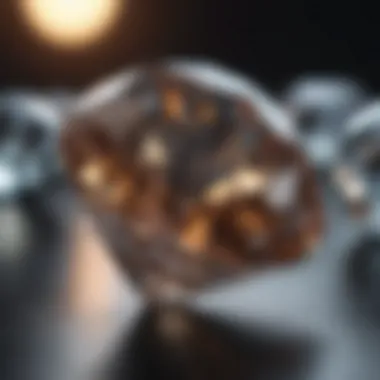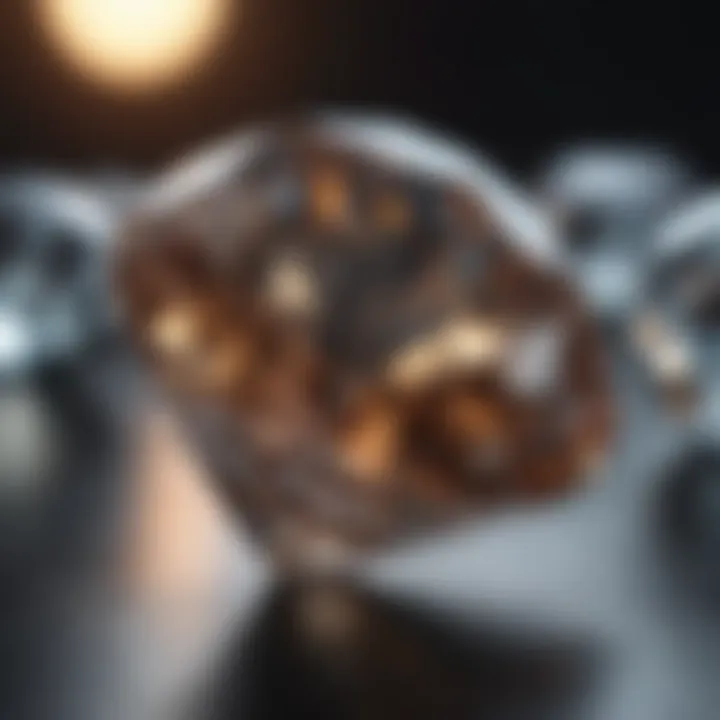Insights into the New York Diamond Company and Trends


Intro
As we embark on a journey to explore the New York Diamond Company, it’s invaluable to first ground ourselves in an understanding of gemstones themselves. The diamond industry, especially in a vibrant market like New York, isn’t just about the larger-than-life stones seen in the windows of glittering jewelry stores. It’s also about the essence of the minerals, their journey through time, and their continuing evolution.
Gemstones have captivated hearts for centuries, serving as tokens of love, status symbols, and even as instruments of war. From their origins deep in the Earth to their ultimate use in exquisite pieces of jewelry, understanding gemstones lays the foundation for appreciating what a company like the New York Diamond Company represents.
In the sections that follow, let’s examine the nature of gemstones, explore their historical significance, and delve into what makes the New York Diamond Company an influential player in this enduring industry.
Historical Overview of New York Diamond Company
The global diamond industry is a tapestry woven with threads of history, economics, and craftsmanship. Understanding the historical backdrop of the New York Diamond Company is not just an academic exercise; it offers invaluable insights into the complexities of the modern diamond market. When examining the evolution and milestones of this company, one grasps the intricacies and subtleties that have shaped both the company and the broader industry landscape.
Founding Years and Evolution
The New York Diamond Company emerged in the early 20th century, precisely when the diamond trade saw a paradigm shift. Setting up shop during a time of economic fluctuation, it was founded by entrepreneurs who recognized the potential for diamonds to become a sought-after luxury commodity. Initially, the company focused on sourcing rough diamonds from South Africa, navigating the turbulent waters of supply chains that spanned continents.
Over the years, the company adapted to the changing landscape of the diamond trade. For instance, merging traditional practices with modern technology, it crafted a competitive edge. The pivot from a primarily import-based model to actively engaging in cutting and polishing practices marked a significant evolution. The founders believed that offering high quality and unique cuts could set them apart. It's not just about the stone but how it’s shaped and presented.
As the company grew, so did its influence. Partnerships with international suppliers and participation in diamond exhibitions solidified its reputation. The New York Diamond Company became a destination for both local jewelers and private collectors alike. As such, its role expanded from mere trader to a pivotal player influencing market trends.
Milestones in the Diamond Trade
Throughout its storied history, the New York Diamond Company has hit significant milestones that are essential to grasping its current standing in the market. One pivotal event was during the post-World War II era. The boom in consumerism brought a renewed interest in diamond jewelry. The company capitalized on this trend, promoting diamonds not just for engagement rings, but for everyday wear, which broadened the customer base dramatically.
Another notable landmark was the adoption of ethical sourcing practices in the 1990s. As awareness about conflict diamonds rose, the company took early steps towards ensuring that all diamonds were sourced responsibly. This painstaking commitment positioned the New York Diamond Company favorably in an increasingly conscious market.
The digital age marked yet another turning point. Embracing e-commerce in the early 2000s, they expanded their reach far beyond New York, hitting shores globally. This shift not only resulted in increased sales but also a new avenue for educating consumers about diamond selection and care, bridging the gap between professionals and everyday buyers.
In essence, the journey of the New York Diamond Company illustrates resilience and keen market adaptation. Each evolution has been a building block, enhancing its legacy and ensuring its relevance in the modern industry. By tracing this history, one can identify the major influences and practices that continue to shape the gemstone market today.
Operational Framework and Business Model
The operational framework and business model of the New York Diamond Company are foundational components that define how it maintains its position as a key player in the diamond industry. This section will elucidate how these elements intertwine to ensure efficiency, customer satisfaction, and growth in a competitive marketplace.
Supply Chain Management
When we talk about the supply chain management at the New York Diamond Company, it’s like the backbone of a well-oiled machine. It isn’t just about sourcing diamonds; it’s about creating a seamless flow from raw material to final product. The proficiency in securing high-quality diamonds directly impacts the final output, setting a standard in the industry. Each diamond must pass through various stages—from sourcing in mines, careful transportation, to skilled craftsmanship—all of which require meticulous management.
Moreover, the New York Diamond Company places significant emphasis on relationship-building with miners and suppliers, which is crucial for ensuring quality and ethical sourcing. They utilize advanced technology to track inventory and monitor supply chain logistics, minimizing delays that could interfere with customer orders. Through strategic partnerships and effective negotiation, diamonds are procured at suitable costs while upholding quality standards.
This approach not only sustains a solid inventory but also fosters trust with customers who seek assurance that their gems are ethically sourced. Overall, a well-executed supply chain is critical not just for operational success but for bolstering the company's reputation in a discerning market.
Sales Strategies and Customer Engagement
In the arena of sales strategies, the New York Diamond Company understands that customer engagement is key to retention and growth. The diamond market thrives on personal relationships, and this firm leans heavily into that concept. They offer tailored experiences, recognizing that purchasing a diamond is often about more than the stone itself. It caters to the emotions tied to events like engagements or anniversaries.
Personalized Consultations are a hallmark of their approach. Customers aren’t just numbers; they receive attention that makes them feel valued. The sales teams are trained not just in the properties and details of diamonds but also in active listening to understand clients’ needs. This ensures that the options presented align perfectly with what the customers envision.
In terms of marketing strategies, the New York Diamond Company enhances its online presence through content-rich platforms, shareable insights, and engaging storytelling. Social media platforms are utilized not just for advertisement but also for sharing information—like educating consumers about the unique characteristics of diamonds or the significance of ethical sourcing.
Additionally, they also take part in local events and partnerships, further cementing their community presence and drawing in potential customers who appreciate craftsmanship and ethical considerations. Through outreach and engagement, they are able to cultivate a customer base that sees value far beyond just the financial aspects of a diamond purchase.
"In a world where options are plenty, it’s often the personal touch that creates loyalty and trust."


By blending targeted sales techniques with genuine customer engagement, the New York Diamond Company not only sells diamonds; they create experiences that resonate and encourage repeat business.
Diamond Characteristics and Quality Standards
Understanding diamond characteristics and quality standards is key when diving into the intricate world of gemstones. This section sheds light on how quality is assessed and why it matters. Diamonds are not merely glittering objects of desire; their attributes influence desirability, pricing, and durability. Collectors and enthusiasts must grasp these elements to navigate the market effectively.
Four Cs of Diamonds: Cut, Color, Clarity, and Carat
When discussing diamonds, the Four Cs are the bedrock of evaluation. Each characteristic represents a facet of the diamond's overall quality and value:
- Cut: This term refers not only to the shape of the diamond but, more crucially, how well it reflects light. A poorly cut diamond, even if flawless and of high carat weight, will sparkle less impressively than one with an ideal cut. The angles and proportions can make a stunning difference, bringing the stone to life under various lighting conditions.
- Color: While diamonds can appear colorless, they actually come in a spectrum. On a grade scale, diamonds range from colorless (D) to light yellow or brown (Z). Pure colorless stones are rare and thus command higher prices. However, fancy color diamonds, like pink and blue, present an entire different worth, often skyrocketing in value due to their rarity.
- Clarity: The clarity of a diamond refers to the presence of internal or external imperfections, known as inclusions and blemishes. A diamond free from such flaws garners top grades, yet many customers might prefer to focus on appearance rather than minute details visible only under magnification.
- Carat: Carat weight measures a diamond's size, but it does not directly equate to its value. Wider, shallower cuts can yield larger carat weights without increasing the value, while deeper, well-proportioned diamonds can achieve more brilliance despite being smaller.
Each of these factors interplay significantly, drawing a complex picture of what defines diamond quality. When seeking a diamond, being informed about these Four Cs enables consumers to make wise choices, ensuring they invest in a gem that truly resonates with their vision.
Certification and Grading Systems
To navigate the diamond market effectively, understanding certification and grading systems is essential. Certifications, from reputable institutions, provide an objective assessment of a diamond’s characteristics. The Gemological Institute of America (GIA) is considered a gold standard within the industry. Their reports include detailed evaluations of all Four Cs, ensuring buyers know exactly what they are getting.
Other notable grading laboratories include the American Gem Society and the International Gemological Institute, each with its own standards. Not only does a certification lend credibility to the diamond, but it also plays a vital role in establishing its value over time.
Choosing a certified diamond means ensuring quality, which is particularly crucial in long-term investment scenarios.
Buyers should always demand a certification when purchasing diamonds, as this verifies authenticity and protects their investment. Additionally, a grading report can be your best friend when it comes to resale, providing potential buyers with confidence in the value of the stone.
The Role of Traditional and Modern Techniques
The diamond industry thrives at the intersection of age-old craftsmanship and modern technological advancements. Both traditional and contemporary techniques play a vital role in the New York Diamond Company's operations. This complex blend allows for a meticulous process that enhances the quality and appeal of the diamonds offered. By appreciating these techniques, stakeholders can comprehend both the artistry involved in diamond creation and the innovative practices that streamline production and amplify quality.
Craftsmanship: From Sourcing to Setting
Traditional craftsmanship is where the journey of every diamond begins. From the selection of raw stones in the mines to the intricate process of setting them into jewelry, craftsmanship reflects the deep-seated values and expertise that have been passed down through generations. Jewelers at the New York Diamond Company often accompany gemologists to source high-quality rough stones, ensuring that only the finest materials are chosen. This hands-on approach cultivates a deep understanding of stone characteristics, ensuring that each selection resonates with excellence.
The transformation of rough diamonds into polished gems requires immense skill. Artisans employ a variety of techniques, such as hand-cutting and precise shaping, which preserve the unique attributes of each stone. It's not just about aesthetics; it's also about maximizing the diamond's brilliance and fire. Moreover, the setting phase adds another layer of artistry—craftsmen meticulously place stones in mountings that not only complement the gem but also voice a brand’s identity and ethos.
"True craftsmanship lies in attention to detail. Each cut and polish transforms the diamond into a sparkling symbol of luxury and elegance."
Innovations in Diamond Processing
While traditional methods are undeniably important, modern techniques have revolutionized the diamond processing landscape. Technologies like laser cutting, computer-aided design (CAD), and advanced imaging systems allow for greater precision and efficiency without sacrificing quality. Utilizing such innovations reduces waste and increases yield from raw stones, ultimately contributing to both sustainability and cost-effectiveness.
Another significant advancement is the use of artificial intelligence in grading and pricing diamonds. By analyzing various parameters, AI systems can provide a more accurate valuation, benefiting both sellers and buyers. This level of analysis would be nearly impossible with manual processes, allowing the New York Diamond Company to maintain a competitive edge in a rapidly evolving market.
Furthermore, innovations aren’t limited to the production process. Marketing and customer engagement strategies have also embraced modern technology. Virtual reality showcases and augmented reality fittings are just a few ways retailers enhance the customer experience. This modern approach to engagement enables consumers to appreciate the craftsmanship behind diamond jewelry without stepping foot in a physical store.
In summary, the role of traditional and modern techniques within the New York Diamond Company creates a dynamic interplay, ensuring that each diamond is not just a gem, but a well-crafted piece of art backed by innovation. This synthesis is key for gemstone enthusiasts and collectors, placing each diamond firmly at the confluence of heritage and futurism.
Market Trends and Economic Impact
Understanding the market trends and economic impact is crucial when discussing the New York Diamond Company. The diamond industry is not just about beautiful stones; it's intricately linked to global economics, consumer behavior, and even social movements. With each facet of the diamond market reflecting broader economic indicators, this section aims to shed light on how these dynamics play a pivotal role in shaping the strategies and operations of companies within this field.
Global Demand and Supply Dynamics
The demand for diamonds can hinge on various factors that are both economic and cultural. Over the last few years, there has been a noticeable shift towards more ethical practices in the gemstone trade. Consumers today want assurance that their purchases are conflict-free. According to recent studies, about 70% of consumers in markets like North America and Europe prefer to buy diamonds that are certified as conflict-free.


Furthermore, the advent of lab-grown diamonds has also reshaped the landscape. These ethically sourced diamonds are not only more affordable but also challenge the traditional market.
- Increased Consumer Awareness: Shoppers are becoming well-informed. They actively seek knowledge about where diamonds come from and how they’re sourced. This knowledge influences purchasing decisions significantly.
- Changing Tastes: The rise of unique, customized jewelry pieces has sparked a growing demand for alternative gemstones. This growing trend can affect the demand for traditional diamonds.
The supply side is equally complex. Mines are facing regulatory hurdles and environmental concerns, which can limit availability. For instance, some countries have tightened regulations on diamond mining to curb environmental damage. The interplay between these factors means that companies like the New York Diamond Company must navigate a tricky path.
Impact of Economic Variables on Prices
Economic variables profoundly influence the pricing strategies of diamonds. Global inflation rates, currency fluctuations, and even geopolitical tensions can creep into diamond pricing.
For example, when inflation rises, the cost of mining and production can increase, which may lead suppliers to pass on these costs to consumers. Additionally, the value of the U.S. dollar against other currencies often impacts import and export prices. A weak dollar typically makes diamonds more expensive for foreign buyers, thereby affecting demand.
- Consumer Spending Power: During times of economic downturn, luxury items like diamonds can see a drop in sales. Consumers may choose to tighten their belts, which has a direct impact on prices.
- Supply Chain Disruptions: Recent global events have highlighted the fragility of supply chains. Disruptions can drive prices up, as seen during the pandemic when mining activities slowed considerably.
"The diamond market reflects not just the shine of the stone but the economic forces shaping our world."
For the discerning consumer, understanding these economic factors provides a deeper appreciation of the true value of a diamond. The New York Diamond Company exemplifies a strategic approach, adjusting pricing practices and marketing strategies in response to these ever-changing dynamics. By staying attuned to both global demands and economic trends, they ensure they remain competitive in a complex environment.
This comprehensive understanding of market trends and their economic implications offers gemstone enthusiasts not just insight but also the foresight needed to navigate their purchasing decisions wisely.
Ethical Sourcing and Sustainability Practices
The notion of ethical sourcing and sustainable practices has become an essential cornerstone in the diamond market. With an increasing number of consumers and stakeholders favoring responsible sourcing, companies like the New York Diamond Company face both challenges and opportunities. Ethical sourcing enhances consumer trust and has the potential to elevate brand loyalty, all while contributing positively to society and the environment.
In this context, it is reassuring to know that diamonds can be sourced without contributing to violence or exploitation. By focusing on procurement strategies that emphasize transparency and responsibility, businesses in this sector can create not just a marketplace, but a movement towards a better industry.
Understanding Conflict-Free Diamonds
Conflict-free diamonds, often referred to as "blood diamonds," are stones extracted from regions where the proceeds from their sale do not fund violence or human rights abuses. Understanding this distinction is crucial because it plays a fundamental role in how diamonds are perceived by conscientious consumers. The Kimberley Process, an international certification scheme, strives to prevent the trade in conflict diamonds. This initiative necessitates that rough diamonds be certified to ensure they haven't funded conflict.
Adoption of such standards signals to potential buyers that the diamonds they purchase are ethically sourced. Moreover, many jewelers and retailers go a step further, engaging in responsible sourcing practices that prioritize the welfare of local communities where these diamonds are mined. The narratives surrounding these stones help create an emotional connection, serving as a reminder that every diamond carries a unique story.
Sustainable Practices in the Industry
Sustainable practices are not merely a trend; they are becoming the foundation for a future where the diamond industry can thrive responsibly.
These practices include:
- Sustainable Mining Techniques: Companies invest in methods that minimize environmental degradation, such as reducing water usage and allowing for better land restoration post-mining.
- Community Engagement: Many firms prioritize engaging with local communities, ensuring they benefit from mining operations. This might include educational programs, job creation, and investing in local infrastructure.
- Recycling and Upcycling: The growing trend of using recycled diamonds and jewelry signifies an important shift towards sustainability. This can create market opportunities while also reducing the demand for newly mined stones.
"A diamond’s value is no longer just in its sparkle, but also in the story it tells."
By recognizing the importance of ethical sourcing and establishing sustainable practices, the New York Diamond Company places itself not just as a player in the market, but as a leader in shaping the future of the diamond industry.
Investment Potential of Diamonds
Investing in diamonds has become a topic of increasing interest among financial enthusiasts and consumers alike. The allure of these precious stones goes beyond their beauty; they present a viable investment opportunity in a world where tangible assets are often more comforting than fleeting stocks or digital currencies. As we delve into the nuances of diamond investment, we will explore crucial elements, benefits, and considerations that potential investors should weigh.
Market Value Appreciation
One of the significant factors driving the investment potential of diamonds is their historical appreciation in value. Unlike many assets that fluctuate with market trends, diamonds have shown resilience over time. Their worth often appreciates due to scarcity combined with growing demand.
- Scarcity: Natural diamonds are finite; the supply is limited, especially for high-quality stones. As mineable sources diminish, the remaining gems tend to increase in value.
- Demand: The global appetite for diamonds, particularly in emerging markets, fuels this appreciation. Nations like China and India, where luxury spending is climbing, oftentimes contribute to an uptick in demand and, thus, diamond prices.
- Heritage: Diamonds are often passed down through generations, contributing to their allure as an investment. This intrinsic value boosts the notion that these gems are timeless and can command significantly higher prices in the future.


In essence, understanding the dynamics of how diamonds appreciate can guide savvy investors toward sound buying decisions.
Risks and Rewards of Diamond Investment
While the prospect of investing in diamonds can be enticing, it is crucial to tread carefully. Just as with any investment, risks exist alongside potential rewards.
- Risks:
- Rewards:
- Market Fluctuation: Prices can be sensitive to economic shifts. A downturn can lead to decreased demand, prompting a drop in value, at least temporarily.
- Authenticity and Certification: Not all diamonds are created equal. The presence of counterfeit stones or those with questionable value can jeopardize an investment. It's vital to buy certified diamonds from reputable dealers.
- Hedging Against Inflation: With inflation on the rise globally, many investors look to hard assets. Diamonds can be a hedge against currency devaluation, making them an attractive alternative.
- Portfolio Diversification: Incorporating diamonds into a broader investment strategy can enhance portfolio diversity, reducing overall risk.
Ultimately, weighing these risks and rewards allows investors to make informed choices that align with their financial goals and risk tolerance.
"Investing in diamonds is not just about monetary value; it reflects a blend of emotional and financial aspects that few other investments can match."
By delving into the investment potential of diamonds, gemstone enthusiasts can recognize not only their intrinsic beauty but also their capacity to serve as valuable financial assets. As the diamond market continues to evolve, so too do the strategies for leveraging this unique investment opportunity.
Consumer Education and Awareness
In today's rapidly evolving diamond market, understanding how to navigate the complexities surrounding gemstones is paramount. Consumer education serves not just as a tool for informed purchasing but also as a safeguard against potential pitfalls that come with the allure of diamonds. For enthusiasts and investors alike, acquiring the knowledge to discern quality and value can lead to more fulfilling experiences and smarter financial decisions.
Guidance on Selecting Quality Diamonds
Choosing a diamond requires more than a glance at its sparkle. Here are some key aspects to consider:
- The Four Cs: Familiarity with Cut, Color, Clarity, and Carat is essential. Each characteristic offers insight into the diamond's quality and value. For example, a well-cut diamond reflects light beautifully, making it appear more dazzling.
- Certification: Always look for a diamond that has been graded by a reputable lab, like the Gemological Institute of America (GIA). This documentation serves as a report card for the gem and adds to its credibility in the market.
- Source and Origin: Consider where the diamond comes from. Ethical sourcing has become a touchstone for many buyers. A diamond that is conflict-free not only supports ethical practices but also aligns with personal values.
- Market Research: Regularly keep an eye on the diamond market trends. Prices can fluctuate based on global demand and supply, and being aware of these changes can guide you on when to buy or sell.
"Knowledge is power; only if applied to decisions that make sense."
Understanding the various factors involved in selecting quality diamonds helps buyers appreciate not only the physical attributes but also the broader implications of their acquisitions.
Caring for and Maintaining Diamond Jewelry
Owning a diamond, particularly if it’s a piece of jewelry, comes with responsibility. Here are some effective care tips:
- Regular Cleaning: Use a gentle solution of warm water and mild dish soap to clean your diamond jewelry. A soft brush can help remove dirt from hard-to-reach areas, keeping the sparkle alive.
- Storage Matters: Store diamonds separately to avoid scratches. A soft pouch or a lined jewelry box can be a good solution.
- Professional Maintenance: Consider having your jewelry inspected by a professional every six months. They can check for loose settings or other potential issues that might arise from daily wear.
- Take It Off When Necessary: Certain activities can be harmful to your diamond ring. Removing it during strenuous tasks like gardening or exercise can prevent damage and maintain its pristine condition.
By understanding how to care for and maintain diamond jewelry, owners ensure that their gems not only retain their value but also remain stunning for generations to come.
The Future of the New York Diamond Company
The future of the New York Diamond Company holds significant implications not only for the business itself but for the diamond industry as a whole. In an age where trends can shift in the blink of an eye, understanding how this prominent player navigates the waters of the gemstone market is crucial. The conversation revolves around how well the company adapts, grows, and positions itself against various challenges. This isn't just survival—it's about seizing opportunities in the face of evolving consumer preferences, technological advancements, and global market dynamics.
Adapting to Market Changes
Navigating market change is akin to sailing in turbulent waters—the New York Diamond Company needs to be agile, adjusting its sails to catch the winds of consumer interest and economic fluctuations. With millennials and Gen Z becoming more prominent in the market, their values including sustainability and ethical sourcing come into play. To stay afloat, the company must tune in to these desires and align its offerings accordingly.
For instance, intuitive use of data analytics can help predict trends, enabling informed decisions regarding inventory and marketing strategies. Implementing technology for virtual try-ons or personalized customer experiences has become not just a benefit, but a necessity. As the need for transparency grows, the New York Diamond Company should reinforce its commitment to ethical practices, ensuring consumers feel confident about their purchases, knowing they come from reputable sources.
"Adapt or perish, now as ever, is Nature’s inexorable imperative." — H.G. Wells
Vision for Growth and Expansion
Looking ahead, the vision of growth for the New York Diamond Company is not merely about increasing sales but rather focusing on sustainable and deliberate expansion. This involves a strategic approach to market penetration and diversification of product lines. By tapping into emerging markets, especially those in regions where diamond appreciation is growing, they can secure a stronger foothold.
Strengthening online presence is another pillar of this vision. A seamless online shopping experience, paired with engaging content that educates consumers about diamonds, can drive significant traffic. Collaborations with influencers and participation in virtual gemstone expos can further expand brand visibility.
Consideration of innovative designs could also resonate well with new age consumers. Limited edition collections and bespoke services can create a buzz and position the company as a trendsetter within the industry.
In summary, the future of the New York Diamond Company is not a mere speculation but a dynamic puzzle requiring careful consideration of market trends, consumer expectations, and technology advancements. With a keen eye on adapting and a heartfelt commitment to ethical practices, the company can look forward to a future shimmering with potential.



